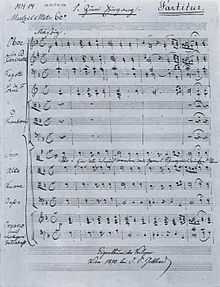Deutsche Messe (Schubert)
| Deutsche Messe | |
|---|---|
| by Franz Schubert | |
 | |
| Catalogue | D. 872 |
| Year | 1827 |
| Form | Mass |
| Text | Johann Philipp Neumann |
| Language | German |
| Movements | 8, with an appendix |
| Vocal | SATB choir |
| Instrumental | wind instruments, timpani and basso continuo |
Deutsche Messe ("German Mass"), D. 872, is a mass composed by Franz Schubert in 1827. Its text is not the Latin liturgical text, but a sequence of poems in German by Johann Philipp Neumann who commissioned the work. It was originally scored for SATB choir, 2 oboes, 2 clarinets, 2 bassoons, 2 horns, 3 trombones, timpani and basso continuo. It is also known as the Gesänge zur Feier des heiligen Opfers der Messe ("Songs for the celebration of the holy offering of the Mass"), and the "Wind Mass" due to its orchestration of primarily wind instruments.[1]
Background
The Deutsche Messe stems from a tradition of low masses, settings of religious texts in vernacular languages in Austria and southern Germany.[2] It was commissioned by Johann Philipp Neumann, who was interested in simple music designed to appeal to "the widest possible congregation".[3] Neumann wrote the German hymns, which Schubert scored in a block-chordal, homophonic style, suitable for congregational singing.[4] Schubert commenced the work in December 1826, completing and publishing it in 1827.[5] Neumann had previously written the libretto for Schubert's unfinished opera, Shakuntala.
Schubert intended it for usage in Catholic church service.[6] However, censorship prevented this from taking place; as an unauthorised German translation of the Mass, it was not approved for liturgical use.[7] The work has since gained popularity, and has been translated into other languages.[8] Richard Proulx arranged a version in English.[5]
Structure
The work contains nine movements, including eight hymns and an appendix. Most of the work is set in a moderate ("mäßig") to slow ("langsam") tempo, reflecting the solemnity of the service as well as consideration of church acoustics.[9]
Each of the hymns has a Latin counterpart in the Order of Mass. Performance time is approximately 40 minutes, if performed as a cycle with all the verses.[1]
- "Zum Eingang" Mäßig, F major, common time
- "Zum Gloria" Mit Majestät, B-flat major, common time
- The scoring of this movement includes an additional 2 trumpets.
- "Zum Evangelium und Credo" Nicht zu langsam, G major, 6/8
- "Zum Offertorium" Sehr langsam, C major, 3/4
- "Zum Sanctus" Sehr langsam, E-flat major, 3/4
- "Nach der Wandlung" Sehr langsam, G major, common time
- "Zum Agnus Dei" Mäßig, B-flat major, 6/8
- "Schlußgesang" Nicht zu langsam, F major, 3/4
- "Anhang" (Appendix): "Das Gebet des Herrn" Mäßig, G major, 6/8
Notes
References
- Shrock, Dennis (2009). Choral Repertoire. ISBN 9780199716623.
- Glover, Raymond F., ed. (1990). The Hymnal 1981 Companion. ISBN 9780898696868.
- Newbould, Brian (1999). Schubert: The Music and the Man. ISBN 9780520219571.
- Biesinger, Joseph A. (2006). Germany: A reference guide from the Renaissance to the present. ISBN 9780816074716.
- Hanson, Alice Mary (1985). Musical Life in Biedermeier Vienna. ISBN 9780521257992.
- Foley, Edward; Bangert, Mark Paul (2000). Worship Music: A concise dictionary. ISBN 9780814658895.
- Montgomery, David (1994). "Tempo, Time, and Character". Franz Schubert's Music in Performance: Compositional ideals, notational intent, historical realities, pedagogical foundations. ISBN 9781576470251.
External links
- Deutsche Messe (Schubert): Free scores at the International Music Score Library Project
- Free scores of Deutsche Messe (Schubert) in the Choral Public Domain Library (ChoralWiki)